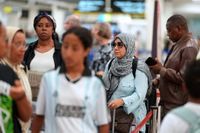For much of the summer of 2025, the United States found itself grappling with an unmistakable downturn in international tourism. From the neon-lit casinos of Las Vegas to the once-bustling border towns like Buffalo, New York, the absence of foreign visitors was both visible and deeply felt. In a year when the world seemed eager to travel again, the U.S. stood out for all the wrong reasons—hosting fewer international guests and raising questions about what, or who, was to blame.
Buffalo’s summer story was emblematic of the broader trend. Hoping to woo back its northern neighbors, the city launched a high-profile marketing campaign along the highway from Toronto, featuring a cheery “Buffalo Loves Canada” billboard and a $500 gift card giveaway. More than 1,000 Canadians entered the contest, according to Patrick Kaler, CEO of Visit Buffalo Niagara. But by the end of July, the usual summer influx of Canadian tourists had failed to materialize. "To see the traffic drop off so significantly, especially because of rhetoric that can be changed, is so disheartening," Kaler told the Associated Press.
This wasn’t just a Buffalo problem. Across the country, from Las Vegas to Los Angeles, major tourist destinations reported noticeable drops in international arrivals. The World Travel & Tourism Council, in a sobering projection ahead of Memorial Day, singled out the U.S. as the only country among 184 studied where foreign visitor spending was expected to fall in 2025. “The world’s biggest travel and tourism economy is heading in the wrong direction,” said Julia Simpson, the council’s president and CEO. “While other nations are rolling out the welcome mat, the U.S. government is putting up the ‘closed’ sign.”
Travel research firm Tourism Economics echoed those concerns, predicting an 8.2% drop in international arrivals for 2025—an improvement from earlier, even gloomier forecasts, but still far below the pre-pandemic highs. "The sentiment drag has proven to be severe," the firm noted, pointing out that airline bookings in May, June, and July showed a "sharp inbound travel slowdown" likely to persist into the fall.
What’s behind this chilling effect? Many experts and local officials point to the return of President Donald Trump to the White House as a major factor. According to reporting from the Associated Press and The Independent, Trump’s revived tariffs, stricter immigration policies, and public jabs—such as offhand comments about acquiring Canada and Greenland—have left a mark on how the U.S. is perceived abroad. Deborah Friedland, managing director at Eisner Advisory Group, put it bluntly: “Perception is reality.” Friedland noted that, alongside rising travel costs and global tensions, the administration’s rhetoric and actions made some foreign travelers feel distinctly unwelcome.
The numbers tell a stark story. U.S. government data showed that, during the first seven months of 2025, the country saw more than 3 million fewer overseas visitors—a 1.6% decline compared to the same period in 2024. Western European arrivals dropped by 2.3%, with Denmark down 19%, Germany 10%, and France 6.6%. The trend was even more pronounced in Asia, where arrivals from Hong Kong, Indonesia, and the Philippines plunged by double digits. Fewer travelers from African countries also made the journey, as did Canadians, who historically have been the largest group of foreign visitors to the U.S.
Canada’s absence was especially notable. Last year, over 20.2 million Canadians visited the U.S., but this year, the flow reversed. For the first time in nearly two decades (excluding two months during the pandemic), more U.S. residents drove into Canada in June and July than vice versa, according to Statistics Canada. In July alone, the number of Canadians returning from the U.S. by car dropped 37% from the previous year, and return trips by plane fell 26%. As a result, Visit Buffalo Niagara shifted its marketing to domestic cities like Boston, Philadelphia, and Chicago, and relied on amateur children’s sporting events to fill hotel rooms.
Other regions, too, felt the impact. The International Lindy Hop Championships, a major swing dance competition scheduled for September in Harlem, was postponed after international competitors—many from Canada and France—withdrew, citing concerns about feeling unwelcome in the U.S. "The climate is still the same and what we're hearing is still the same, that (dancers) don't want to come here," said co-producer Tena Morales. Organizers are now considering moving the event abroad until the political climate shifts.
Even Washington, D.C., the nation’s capital, projected a 5.1% drop in international visitors for the year. In response, the city’s tourism marketing arm, Destination DC, announced plans to “counter negative rhetoric” with a campaign showcasing the “more personal side” of the city and its residents.
Of course, not every corner of the country was left wanting. In eastern Wisconsin’s Door Peninsula, which juts into Lake Michigan and Green Bay, the summer was bustling thanks to loyal Midwest visitors. “Many business owners reported a noticeable uptick in foot traffic after a quieter start to the season,” said Jon Jarosh, spokesperson for Destination Door County. By midsummer, sidewalks were busy and restaurants were packed, a rare bright spot in an otherwise challenging season for U.S. tourism.
Airlines, too, found some reason for optimism. Executives from major carriers reported that American passengers booking premium airfares helped fill international flights, and domestic demand was on the rise after a slow first half of the year. The Federal Aviation Administration braced for what was expected to be the busiest Labor Day weekend in 15 years, with bookings up 2% compared to 2024, according to analytics firm Cirium.
Still, the overall mood among tourism professionals was somber. The World Travel & Tourism Council’s warning that “the global appeal of the U.S. is slipping” resonated in many quarters. As Kaler of Visit Buffalo Niagara put it, “We will always welcome Canadians back when the time is right. I don’t want Canadians to feel like we see them as just dollar signs or a transaction at our cash registers. They mean more to us than that.”
For now, the U.S. finds itself at a crossroads. With other countries rolling out the red carpet for international travelers, America’s image as a welcoming destination has taken a hit. Whether this downturn proves temporary or signals a longer-term shift remains to be seen, but one thing is clear: the summer of 2025 will be remembered as a season when many foreign visitors stayed away—and the reasons why are as much about perception as policy.

